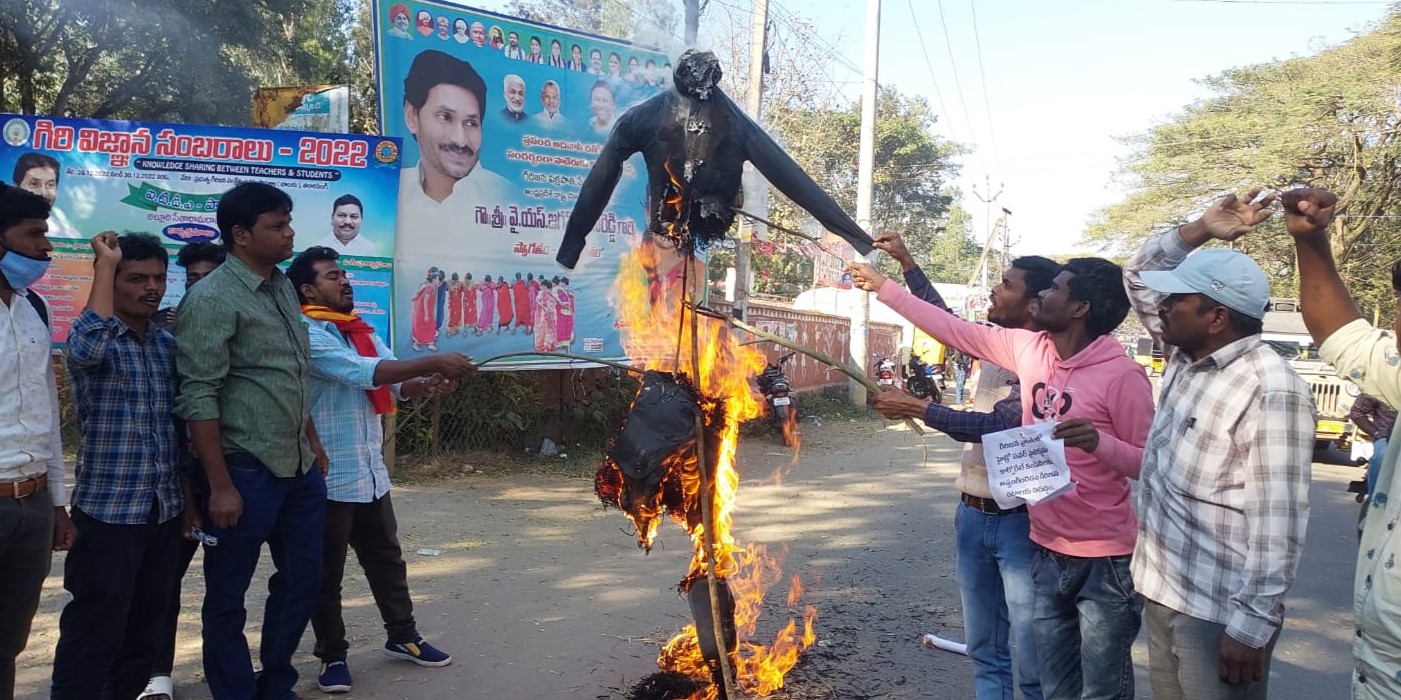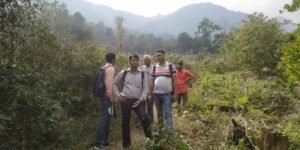Out of the four proposed PSPs envisaged in the Schedule-5 region, three are being set up by Adani Green Energy Ltd.

Andhra Pradesh tribals and activists burn an effigy marked "Adani" in protest against PSPs on their land. (Supplied)
At least seven Pumped Storage Hydroelectric Projects (PSPs) across Andhra Pradesh, approved by the YS Jagan Mohan Reddy government with much fanfare, have landed in hot waters.
Trouble appears to be brewing against at least four of the PSPs planned in the Schedule-5 region of tribal tracts, which have constitutional protection under several laws.
These include the Panchayat (Extension to Scheduled Areas) Act or the PESA, and the Scheduled Tribes and Other Traditional Forest Dwellers (Recognition of Forest Rights) Act or the FRA).
Of the four proposed PSPs envisaged in the Schedule-5 region, three are being set up by Adani Green Energy Ltd.
Andhra Pradesh has been trying to make a big push for green energy.
It was tipped to emerge as a hub for green energy generation in India, with the state Cabinet — in September last year — giving its nod to projects that had a collective investment of ₹81,043 crore.
“It is unfortunate that the government has been going ahead with the PSPs with scant regard to our concerns,” the AP Girijana Sangham national executive member Pachipenta Appala Narasa told South First.
The AP Girijana Sangham is an affiliate of the CPI(M) that works exclusively for tribals and their rights.
“At least 34 villages will be affected by the two PSPs that come under the ASR district. Until now, there has been not even a single meeting from the authorities to explain to us what would happen or to give us any kind of assurance. We will not allow these projects,” he added.

Local tribals stopped and prevented a team of engineering officials from conducting a survey for the Pedakota PSP. (Supplied)
A few days ago, local tribals stopped and prevented a team of engineering officials — who visited the Pedakota, Regulapalem, and Kondimbakota villages in the Ananthagiri mandal — from conducting a survey for the Pedakota PSP.
The tribals also burnt an effigy labelled “Adani” in protest of the government’s proposal.
The newly formed Hydro Power Project Vyathireka Aikya Karyacharana Samithi has decided to hold a massive meeting in Chintapalli in the Alluri Sitharama Raju (ASR) district against these projects on 21 January to garner support from locals and also make their voice louder.
Of the total seven PSPs approved by the government, four are in Schedule-5 regions.
These include the Yerravaram PSP in Chintapalli and the Koyyurumandals and Pedakota PSP in the Ananthagiri mandal, both in the ASR district.
Two others are Kurukutti in the Salur mandal and Karrivalasa in the Pachipenta mandal, both in the Parvathipuram-Manyam district.
While Adani Green Energy Ltd has been permitted to set up the PSPs in Kurukutti, Karrivalasa, and Pedakota, the Yerravaram project has been handed over to Shirdi Sai Electricals.
The recently-created New & Renewable Energy Development Corporation of AP (NREDCAP) is the nodal agency for these projects.
Each of these projects is to have an installed capacity of 1,000 MW and above.
While NREDCAP has already sent a proposal to the Central Forest and Environment Department for environmental clearances for the 1,000-MW PSP at Gandikota in the YSR district, the Environmental Impact Assessment (EIA) study for the Yerravaram project and the pre-feasibility study of the Pedakota PSP have been launched.
After the study, the EIA report will be submitted to MoEF to secure Environmental Clearance (EC).
Provisions under PESA and the FRA state clearly that any decision on a project in Schedule-5 areas without an informed discussion and the prior consent of the local Grama Sabhas would be illegal.
PESA stipulates that no project in the scheduled area could even be conceived without the prior consent of local Adivasi Grama Sabhas.
“In respect of these PSPs, no information has been conveyed, no discussion has taken place, there has been no transparency, and tribals in these areas have been deliberately kept in the dark,” said Human Rights Forum (HRF) AP general secretary Y Rajesh.
“Leasing out land in the scheduled areas is governed by the AP Land Transfer Regulation (LTR). The Supreme Court laid out in the Samata case of 1997 that private entities cannot undertake projects in the scheduled areas,” he pointed out. “The present proposals are in violation of this seminal judgment.”
Rajesh also claimed: “Moreover, the government has not even bothered to hold a discussion and prior consultation on these projects in the Tribal Advisory Council (TAC) despite this being a statutory requirement.”
HRF teams in recent months visited all four sites and interacted with local people who are predominantly Adivasis.
“We are shocked at the brazen manner in which approval for these projects was granted in open contempt of the law and various Constitutional provisions applicable in Schedule-5 regions,” said HRF AP&TS Coordination Committee member VS Krishna.
“Adivasis in the scheduled areas oppose these projects because they correctly perceive them as being harmful to their livelihood and well-being,” he added.
Each of these PSPs envisages an upper and lower reservoir. The total area required for both reservoirs in the Yerravaram project to generate 1,200 MW is 820 acres, and for the Pedakota PSP to generate 1,000 MW, it is over 680 acres.
This would entail the physical displacement of tribals in the scheduled areas.
According to estimates by the local tribals, not less than 34 habitations located in the Gondhipakalu and Errabommala panchayats in the Chintapalli mandal and P Makavaram panchayat of Koyyuru mandal would be submerged by the Yerravaram project.
These projects also involve drawing water from local sources used by tribals for both domestic needs and agriculture.
The streams and water bodies from which this draw will take place are part of the catchment for various reservoirs.
In the Yerravaram PSP, it is the Thandava reservoir; for Pedakota PSP, it is the Raiwada reservoir.
PSPs in the Parvathipuram-Manyam district will take water from the catchment of the Suvarnamukhi river, which feeds the Vengalrayasagar reservoir.
Parallels between the current government’s efforts to build these PSPs are also being drawn with the attempts by the previous governments to push bauxite projects in the same region. The plans were eventually dropped due to stiff resistance from the local tribals.
“The current government is committing the same mistake that the previous governments made with bauxite projects. Instead of first taking the opinions and views of the local tribals, which is mandated under the law, the government is trying to impose its programmes forcibly on them, threatening their rights and livelihoods,” human rights and environmental activist Ganjivarapu Srinivas told South First.
“The government should hold discussions with them and clear any doubts and insecurities the tribals have in such projects, and proceed only after that,” he added.
“But, unfortunately in the case of tribals, everything comes from the up, and they at the bottom have to accept it.” rued Srinivas.
“Take the instance of bauxite projects the government had eventually bowed out of due to the rights and aspirations of the tribals. Imagine the kind of energies and resources that went to waste,” he said.
In a PSP, the water stored in an Upper Reservoir passes through the waterways to the turbines installed at the powerhouse to generate power during peak hours, and then the water passes through the tail race tunnel to store water in the lower reservoir.
The excess water from the reservoirs, if any, is discharged through the spillway.
During off-peak hours, the excess power from thermal stations and other sources is fed back to pump the water from the lower reservoir to the upper one through the powerhouse, where generators and turbines then act as motors and pumps, respectively.
According to the Terms Of Reference (ToR) submitted to the Union Ministry of Environment, Forest and Climate Change to conduct the EIA and environmental management plan for the Yerravaram project, the NREDCAP said the proposed area consisted of the Kitabhu villages, comprising about 10 households, which would be submerged due to the formation of the lower reservoir.
The cost of the project is estimated to be ₹5,404.07 crore.
The government had identified at least 29 locations in Andhra Pradesh that had the potential to generate 33,240 MW through PSPs.
Projects at seven locations with an estimated potential of 6,600 MW were taken up in the first phase, and the DPRs are under preparation.
Out of the seven locations, four are on-river (reservoir-based) projects and three locations are off-river projects.
The state energy officials informed Energy Minister Peddireddy Ramachandra Reddy in one of the review meetings that Phase –I Feasibility reports (FRs) were submitted to different directorates of the Central government — including the Central Electricity Authority (CEA), Central Water Commission (CWC), Geological Survey of India(GSI) & Central Soil, and Materials Research Station (CSMRS).
According to the estimates of the state government, the peak electricity demand of Andhra Pradesh had been increasing at a fast pace and was estimated at 11,843 MW for the year 2021-22.
By the end of December 2019, renewable energy power projects with a total capacity of 8,142.768 MW have been commissioned in Andhra Pradesh. The majority of which are solar and wind schemes.
State Investment Promotion Board (SIPB) had approved PSPs in December and said that Adani Green Energy Projects will come up in Vizianagaram and the ASR district with an investment of Rs 6330 crore. It will give direct and indirect employment to 4000 people. The officials then also said over 4,196 million units of electricity per year will be generated from the units.

Apr 24, 2024

Apr 24, 2024

Apr 24, 2024

Apr 24, 2024

Apr 24, 2024

Apr 24, 2024